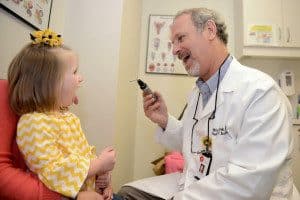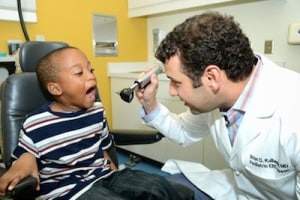
The tonsils are located at the sides of the throat, while the adenoids are located at the top of the throat, behind the nose. Removal of the tonsils and adenoids is a fairly common throat procedure for children, in order to help stop chronic infections in the case of the tonsils, and to help with breathing problems in the case of adenoids. The expert surgeons in throat conditions at Pediatric ENT Associates at Children’s of Alabama in Birmingham, are highly experienced and will give your child the best care possible before, during, and after surgery.
Tonsil Infections in Children
A tonsil infection can be caused by bacteria or viruses. Symptoms of an infection might include:
- Throat that feels scratchy or sore
- Tonsils that are red or swollen
- Yellow or white coating or spots on the tonsils
- Pain when swallowing
- Bad breath
- Swollen lymph nodes in the neck
- Fever
- Headache
- Stomach ache (usually in younger children)
Diagnosing an infection is typically done through a physical examination. If strep is suspected, a throat swab might also be performed. This quick test takes a small sample from the back of the throat, which can be examined in a lab for evidence of bacteria. An initial result can be available within minutes, but the more reliable lab test typically takes a day or two before the results are available.
A tonsillectomy is usually considered when a child:
- Has multiple infections in a year
- Misses a significant amount of school due to throat discomfort
- Has difficulty sleeping due to enlarged tonsils
- Gets tonsil stones frequently
- Has an abscess or other type of growth on the tonsil
Enlarged Adenoids
Adenoids may become enlarged to fight off an infection or due to allergies. Most of the time, the swelling goes down on its own. In some cases, the adenoids become infected and remain enlarged. Symptoms of infection in the adenoids include:
- Difficulty breathing through the nose
- Dryness due to breathing through the mouth
- Breathing that is noisier than usual
- Bad breath
- Snoring or obstructive sleep apnea
- Swollen lymph nodes in the neck
- Sore throat and difficulty swallowing
Enlarged adenoids are also diagnosed through a physical examination in most cases. Occasionally, an x-ray may also be ordered. When enlarged adenoids occur frequently or do not respond to medication, an adenoidectomy may be recommended.
Tonsillectomy and Adenoidectomy Treatment Options

Often, the tonsils and the adenoids can be removed in the same procedure. If both the tonsils and adenoids are inflamed or enlarged, it makes sense to remove them both at the same time, as the procedures are similar and the tonsils and adenoids are located close to each other. Again, this decision will be arrived at by your Pediatric ENT Associates at Children’s of Alabama surgeon after a thorough examination and discussion with you and your child.
For more information about tonsillectomy and adenoidectomy treatments, visit ncbi.nlm.nih.gov.
Tonsillectomy
Tonsillectomy treatment is the removal of the tonsils. The decision to have the tonsils removed is one that is arrived at after careful consideration of all options. A tonsillectomy treatment is a fairly short procedure, usually lasting around half an hour to an hour. Your child will be under anesthesia the entire time, and will not remember the surgery.
Tonsillectomy treatments are usually performed to address chronic infections of the tonsils which may lead to swallowing problems. Your pediatrician or ENT specialist will assess your child and their medical history to determine if tonsillectomy treatments are the best option for your child’s health and well-being. To learn more about tonsillectomy, visit medlineplus.gov.
Adenoidectomy
Adenoidectomy treatment is the removal of the adenoids, which are small glands located at the top of the throat. The adenoids can become enlarged or inflamed, leading to difficulty breathing, snoring, and obstructive sleep apnea, among other problems. If your child is suffering from problems such as these, it is a good idea to have their adenoids looked at and determine if removal is the best option. Often, after an adenoidectomy treatment, children feel much better and can breathe more easily. This can translate into their daily life, too, as they can get a better night’s sleep and thus focus better during the day.
Surgery Treatment
Tonsillectomy and adenoidectomy surgeries have been done for hundreds of years, and are generally very safe and low risk. The surgeon is able to do the surgery through the child’s open mouth, eliminating the need for any incisions. Your child will be under anesthesia during the procedure, but to make the experience as comfortable and non-threatening as possible, no needles will be inserted while your child is awake. Instead, the pediatric anesthesiologists at our otolaryngology clinic are able to use a mask through which the child can breathe a calming sleep medication to prevent any anxiety associated with needles.
Pediatric Tonsillectomy Recovery
The recovery process varies for every child, but recovery for kids is typically quicker than for adults. Your child may need up to one week of rest before they can return to school or daycare, and two weeks before they can return to all their regular activities. Ear and throat pain that lasts a full two weeks is typical for kids. Many children do not need this long to recover, however.
Common post-op symptoms include:
- Fever up to 102 degrees on the day of and day after surgery
- Bad breath for two weeks
- Unusually tired
- White scabs where tonsils were removed which fall off after five to ten days
- Blood in saliva from scabs
- Snoring/breathing through the mouth for 10-14 days (humidifier can help keep throat hydrated during this time)
- Change in voice for two to three weeks
- Weight loss while drinking liquids (weight should return after your child starts eating solid foods again)
During this recovery period, you can help your child heal by encouraging them to stick with restful activities, giving them easy-to-swallow foods, and sticking with their medication schedule, if any. For the first few days, your child may want to stay in bed. When they are ready to get up, quiet, indoor play is best. They should avoid sports or any strenuous play for two full weeks. If they head back to school or daycare after a week at home, they should not participate in gym class or any activity where they could turn upside down, like the monkey bars or somersaults.
Your child will need to drink lots of cool liquids for the first 24 hours, but nothing hot or containing citrus. When they are ready to eat, serve them soft foods like noodles, pudding, mashed potatoes, and scrambled eggs. Dairy can cause their saliva to thicken, making it harder to swallow, so have them try dairy-rich foods in small quantities. If you ever have any questions, contact our office anytime.
Schedule a Tonsil Appointment with an ENT Specialist At Our Birmingham Otolaryngology Clinic
If your child is having problems with their tonsils or adenoids, schedule an appointment with an expert ENT pediatrician at Pediatric ENT Associates at Children’s of Alabama in Birmingham. To make an appointment at our otolaryngology clinic call (205) 831-0101 today!
